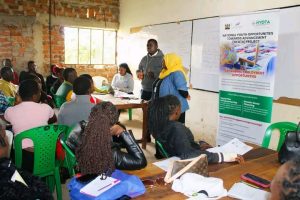Kenya WFP Country Director Embraces AI to Proactively Combat Food Insecurity at a dedicated panel on AI.
Today marks a significant milestone in the humanitarian sector in Kenya with Artificial Intelligence. As Lauren Landis, the Country Director for the World Food Programme (WFP) in Kenya, took center stage at a dedicated panel to discuss the transformative role of Artificial Intelligence (AI) in humanitarian efforts.
Lauren Landis, A Leader in Humanitarian Innovation
Lauren Landis has a long-standing career in the humanitarian field, bringing over 25 years of experience to the table. Before joining WFP, she worked with various international organizations, including the United Nations and several non-governmental organizations (NGOs). All focusing on emergency response, food security, and program management. In addition, Her leadership in Kenya has been instrumental in driving innovative solutions to complex humanitarian challenges.
At today’s panel, Lauren emphasized the critical importance of partnerships in harnessing the power of AI. She highlighted an ongoing collaboration with Google that aims to enhance Early Warning Systems for Anticipatory Action (SEWAA).
The Role of AI in Humanitarian Efforts
“Through partnerships with Google, Oxford University, and other key stakeholders, we can build trust in early warning systems. This enables WFP in Kenya to be seen not only as a responder but also as an enabler,” Lauren noted. Her statement underscores the shift from reactive to proactive measures in humanitarian operations, facilitated by cutting-edge technology.
The SEWAA project is a collaborative initiative involving Google, the University of Oxford, the IGAD Climate Prediction and Applications Centre (ICPAC), the Kenya Meteorological Department (KMD), and the Ethiopia Meteorological Institute (EMI). This project leverages AI technology to enhance early warning systems for extreme weather events, aiming to protect vulnerable communities in the Greater Horn of Africa (GHOA) region, particularly in Kenya and Ethiopia.
SEWAA: Harnessing AI for Early Warning
SEWAA utilizes a Conditional Generative Adversarial Neural Network (CGAN) model to improve the accuracy of weather forecasts. This technology enhances low-resolution weather data to high-resolution forecasts at the household level, providing frequent updates through cost-effective cloud-based GPU systems. Such advancements enable governments to take proactive measures during the critical window between early warning alerts and severe weather impacts.
Key Takeaways from the Panel
The panel discussion provided several insights and takeaways that are pivotal for the future of humanitarian operations:
- Innovative AI Investments: Highlighting the ongoing investments in AI and their benefits for humanitarian operations, including proactive response and timely decision-making.
- Insights from AI Leaders: Discussing the imperatives for sustainably adopting AI in global organizations.
- Effective Partnership Models: Exploring how partnerships between WFP, governments, and the private sector can advance AI-driven solutions.
A Vision for a Resilient Future
This panel reflects WFP’s vision, aligned with the UN 2.0 initiative, which aims to leverage AI and frontier technologies to promote inclusivity, reduce inequalities, and advance the Sustainable Development Goals (SDGs). The collaboration between WFP and leading technological and academic institutions showcases a model for successful partnerships that can drive significant advancements in humanitarian efforts.
The Broader Impact of AI in Humanitarian Work

The integration of AI into humanitarian operations represents a paradigm shift in how organizations respond to crises. By moving from reactive to anticipatory action, WFP and its partners can mitigate the impacts of disasters before they occur. This not only saves lives but also reduces the economic burden on affected communities and enhances overall resilience.
Lauren Landis’ Commitment to Innovation
Lauren Landis has been a staunch advocate for integrating innovative technologies into humanitarian work. Under her leadership, WFP in Kenya has become a hub for pioneering initiatives that leverage AI. Also, WFP In Kenya Embraces AI through data analytics, and other advanced technologies to address food insecurity and respond to emergencies more effectively.
Her vision extends beyond immediate crisis response, focusing on long-term solutions that empower communities and build sustainable systems. The SEWAA project is a testament to her commitment to driving innovation in the humanitarian sector.
Conclusion
The insights shared at the panel today underscore the transformative potential of AI in humanitarian operations. Through strategic partnerships and innovative projects like SEWAA, WFP is not only responding to crises but also enabling communities to anticipate and prepare for future challenges.
Together, we are paving the way for a more resilient and inclusive future. The collaboration between WFP, Google, Oxford University, and other stakeholders demonstrates the power of collective action in advancing humanitarian goals.
As Lauren Landis continues to lead with vision and determination, the future of humanitarian aid looks promising, with AI playing a central role in driving impactful and sustainable change.





